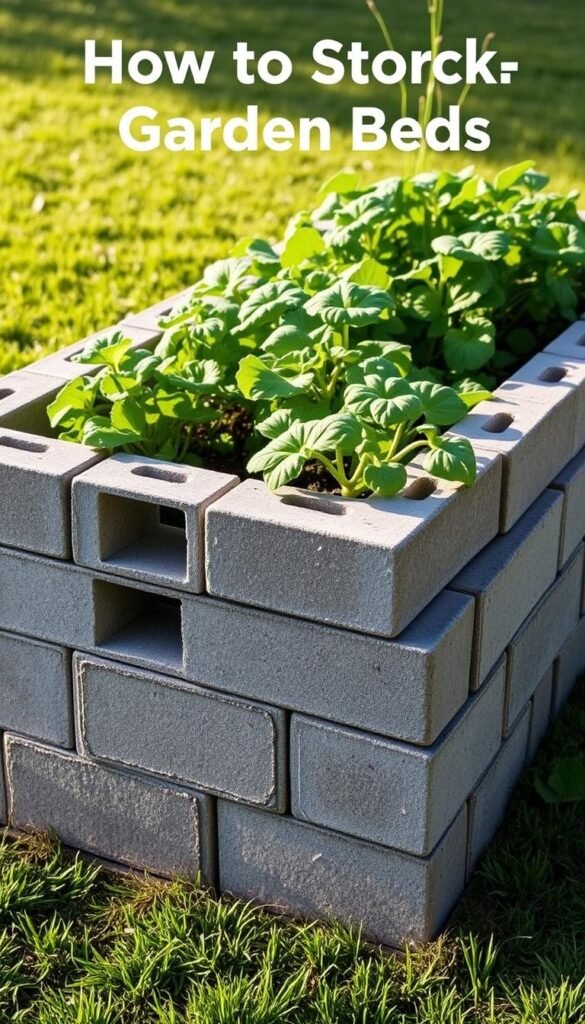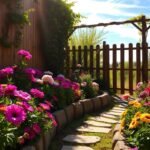Looking for a long-lasting way to grow fresh herbs or vegetables? Concrete building materials offer surprising advantages for creating customized planting areas. These structures provide better drainage than traditional wooden setups while maintaining soil quality season after season.
You’ll love how simple it is to arrange these versatile blocks into shapes that fit your yard perfectly. Unlike pricier options that warp or rust, this method delivers professional-grade results without the hefty price tag. Many gardeners find they save over 60% compared to pre-made kits from home improvement stores.
What makes this approach stand out? The air pockets in each unit naturally regulate moisture levels, preventing root rot during heavy rains. You can easily expand your layout as your skills grow—no special tools required. Plus, the neutral gray color blends seamlessly with any backyard aesthetic.
This guide will show you how to maximize every dollar while building a resilient foundation for your plants. From choosing the right location to optimizing soil depth, you’ll gain practical tips that ensure success in your gardening journey.
Getting Started with Cinder Block Raised Garden Bed Ideas for Sturdy, Budget-Friendly Builds
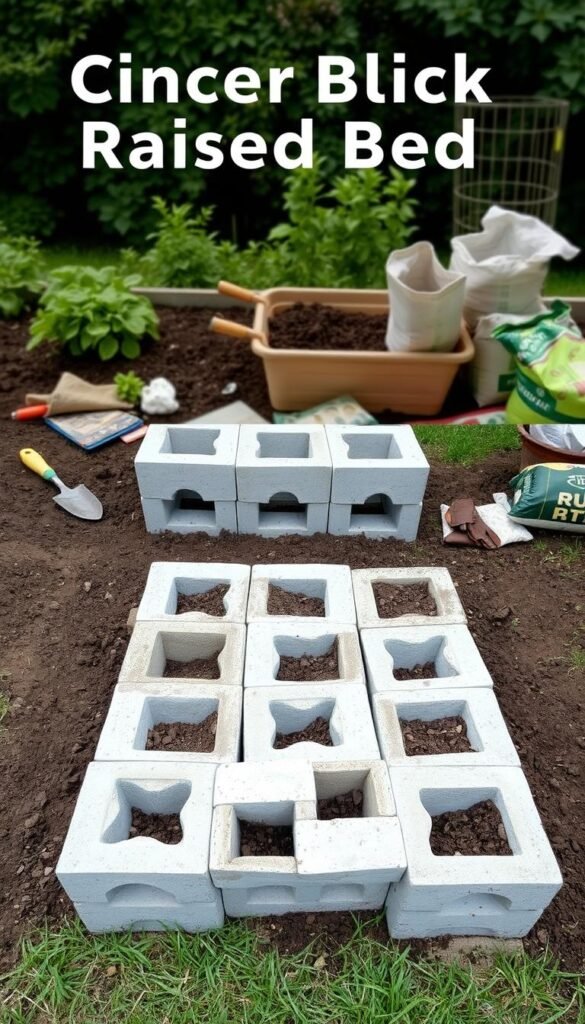
Ready to transform your outdoor space into a thriving plant haven? Start by sketching your vision on paper. Jot down how much room you have and what crops you want to grow. This simple step helps avoid costly mistakes later.
Sunlight patterns make or break your harvest. Track how light moves across your yard for 2-3 days. Most vegetables need 6+ hours of direct sun daily. If shade dominates, consider leafy greens instead of tomatoes or peppers.
Water access often gets overlooked. Place your planting area within 10 feet of a hose connection. This prevents backaches from hauling watering cans across the lawn. Test your soil’s drainage by digging a 12-inch hole and filling it with water.
| Factor | Ideal Condition | Quick Fix |
|---|---|---|
| Sun Exposure | 6-8 hours daily | Use reflective mulch |
| Space Between Beds | 24-36 inches | Narrow pathways |
| Soil pH Level | 6.0-7.0 | Add lime or sulfur |
Gather basic tools like a measuring tape, level, and work gloves before shopping for supplies. Most projects take 1-2 weekends from start to finish. Remember: Perfect measurements matter less than consistent effort.
First-time builders often worry about complex designs. Keep it simple—rectangular shapes work best for beginners. You can always expand later as your confidence grows. The key is creating a functional foundation that supports your green ambitions.
Understanding the Benefits of Raised Garden Beds
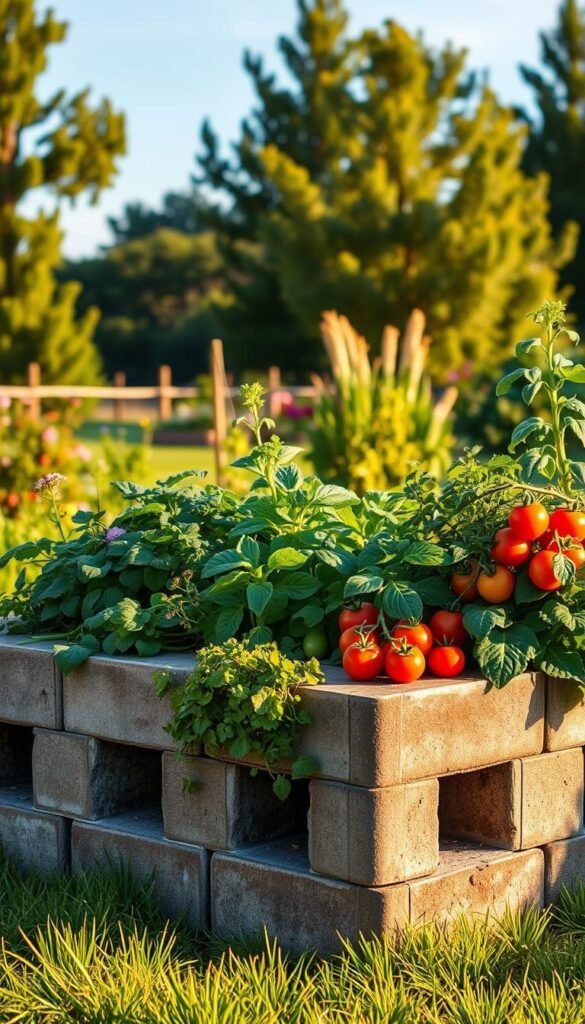
Have you ever struggled with rocky ground or poor drainage in your yard? Elevated planting areas solve these common problems while giving your greens a nutrient-packed home. Unlike traditional plots, these structures let you tailor the earth mixture to your plants’ exact needs—no more guessing games with native dirt.
Warmer soil in spring gives seedlings a head start. This thermal advantage means you can sow seeds weeks earlier than neighbors using flat gardens. Root vegetables like carrots thrive in the loose, uncompacted earth that these setups provide.
Maintenance becomes a breeze with waist-high designs. You’ll spend less time bending over and more enjoying your harvest. Weeding narrow areas takes minutes instead of hours, and pests struggle to reach your crops through the contained walls.
Here’s why gardeners love these systems:
- Custom soil blends prevent nutrient deficiencies
- Improved drainage protects against root rot
- Extended growing seasons boost yields
- Accessible height reduces physical strain
For those exploring square-foot gardening, these beds make spacing calculations simple. The defined boundaries help organize crops while maximizing every inch. You’ll notice healthier growth patterns as roots spread freely without competition from weeds.
Seasoned growers often remark: “Once you try elevated planting, you’ll never go back to ground-level gardens.” The combination of controlled conditions and ergonomic design creates an environment where both plants and people flourish.
Materials and Tools You Will Need
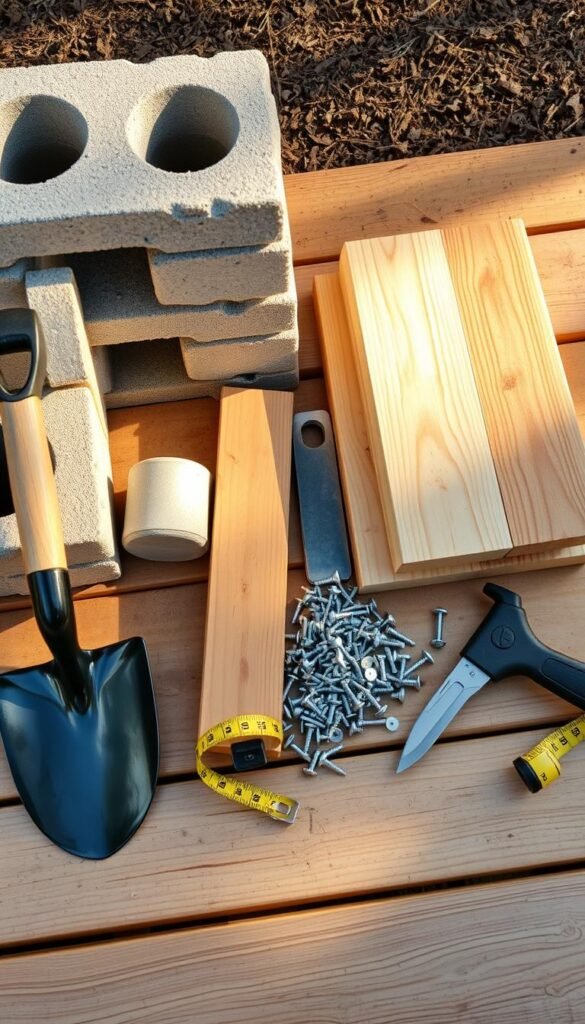
Smart material choices make all the difference when creating durable planting spaces. By selecting the right components upfront, you’ll avoid mid-project headaches and enjoy a setup that lasts for seasons.
Essential Building Supplies
Concrete blocks form the backbone of your structure. These hollow units cost less than traditional wood options while offering better weather resistance. Pair them with landscape fabric to prevent weeds and maintain soil quality.
You’ll need nutrient-rich soil blends to fill your planting area. A 50/50 mix of compost and topsoil works best for most vegetables. Don’t forget basic tools like a rubber mallet for adjusting blocks and a level for even placement.
Budget-Friendly Options and Sustainable Choices
Save money by repurposing materials you already own. Old bricks or reclaimed wood can substitute for pricey decorative caps. Check local community boards for free or discounted supplies—many homeowners give away leftover construction materials.
Consider these cost-cutters:
- Borrow tools from neighbors instead of buying new
- Use newspaper layers under fabric for extra weed blocking
- Create compost from kitchen scraps to reduce soil costs
One seasoned gardener notes: “My total expense was under $40 using recycled blocks and homemade compost.” With smart planning, you can achieve professional results without straining your wallet.
Selecting the Right Location and Design for Your Garden Bed
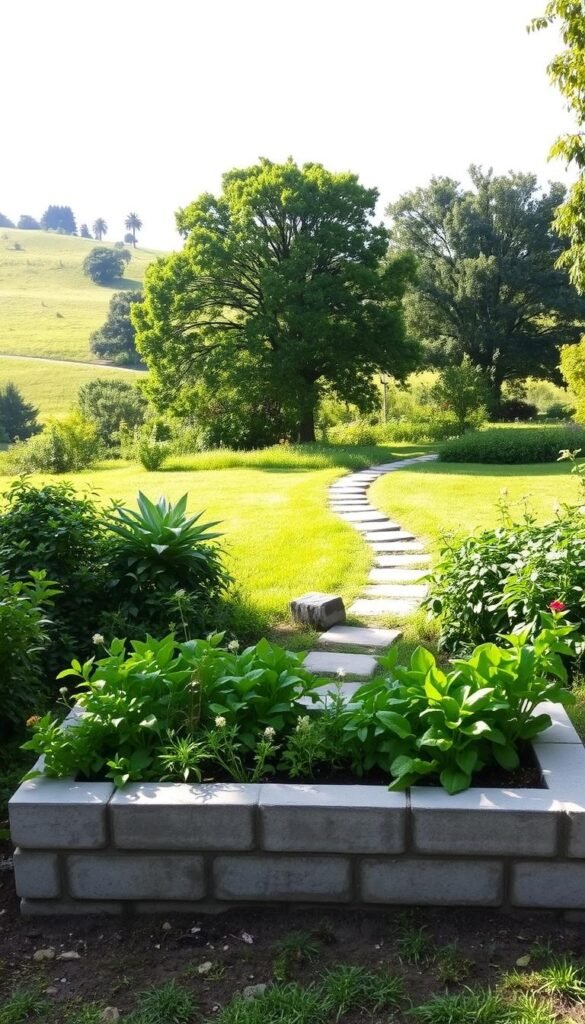
The success of your planting project starts with smart positioning. Watch how sunlight travels across your yard over three days—most crops need that golden 6-hour daily minimum. Sloped areas might look charming but can cause water runoff issues during storms.
Drainage matters as much as sunshine. Test your soil’s absorption by pouring a gallon of water into a dug hole. If it drains slower than 1 inch per hour, consider adding gravel layers beneath your structure. This prevents soggy roots while keeping your foundation stable.
Think about your future harvests when planning bed dimensions. Leafy greens need just 6 inches of soil depth, while tomatoes demand 12+ inches. Leave 18-inch walkways between structures for easy access—you’ll thank yourself during weeding season.
| Design Factor | Vegetable Needs | Space-Saving Tip |
|---|---|---|
| Row Length | 3-4 feet max | Use vertical trellises |
| Bed Height | 12-18 inches | Stack blocks vertically |
| Water Access | Within 15 feet | Install drip lines |
Rectangular layouts maximize growing space for veggies, but L-shaped designs work wonders in corner areas. One gardener shared: “My curved beds near the patio became the talk of our neighborhood—functional and eye-catching!”
Keep your hose or watering can within arm’s reach. Positioning near rain barrels or irrigation systems cuts maintenance time in half. Remember—your plants will thrive where convenience meets practicality.
Step-by-Step Guide to Building Your Garden Bed
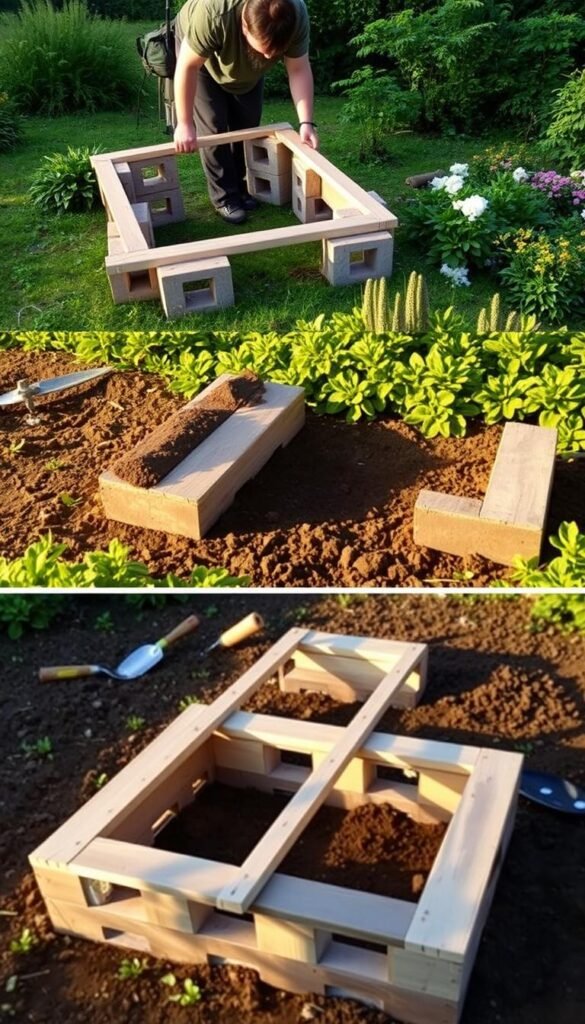
Let’s roll up our sleeves and create a planting space that stands the test of time. This hands-on process combines precision with practicality, ensuring your greens get the strong foundation they deserve.
Measuring, Marking, and Preparing the Space
Grab stakes and string to outline your layout. Measure twice to confirm dimensions match your plan—common sizes range from 4×4 feet for herbs to 8×3 feet for veggies. Clear grass and roots from the marked zone using a flat shovel.
Use a carpenter’s level across the cleared area. Add or remove soil until your foundation stays bubble-centered. This prevents uneven settling that could tilt your structure later. Pro tip: Water the ground lightly to check drainage before building.
Assembling the Frame and Installing the Base
Lay your first layer of blocks, checking each unit’s position with the level. Stagger joints between layers for better stability. One gardener shared: “Taking five extra minutes to align blocks perfectly saved me hours of fixes next season.”
Line the bottom with landscape fabric, securing edges under the first course. This barrier stops weeds while letting excess water escape. For extra protection against burrowing pests, add hardware cloth before the fabric.
| Step | Tool Needed | Time Estimate |
|---|---|---|
| Ground Prep | Shovel + Rake | 1-2 hours |
| Block Placement | Level + Mallet | 3-4 hours |
| Barrier Install | Staple Gun | 30 minutes |
Double-check every third block’s alignment as you build upward. Small errors multiply quickly—a 1/4-inch tilt on the first layer becomes 1-inch slant by the fourth course. Keep your shovel and level handy for on-the-spot adjustments.
Preparing the Foundation: Soil, Drainage, and Mulch
What separates thriving plants from struggling ones? It starts beneath the surface. Your growing space needs a balanced foundation that feeds roots while letting excess moisture escape. Get this right, and you’ll see faster growth with fewer headaches.
Choosing the Best Soil Mix
Think of your planting area as a layered cake. Start with equal parts screened topsoil and compost for nutrients. Add perlite or coarse sand to keep the mixture light—this combo lets roots breathe while holding moisture. Avoid using dirt straight from your yard; it often packs too tightly.
| Component | Purpose | Ideal Ratio |
|---|---|---|
| Compost | Nutrient boost | 33% |
| Topsoil | Structure base | 33% |
| Perlite | Aeration | 34% |
One gardener learned this the hard way: “My first attempt used pure compost—plants drowned after heavy rains. Now I mix in grit for better drainage.”
Ensuring Proper Drainage and Mulching Techniques
Drainage holes are your safety net against waterlogged roots. If using containers, drill 1/2-inch openings every 6 inches along the base. Test your setup by pouring 2 gallons through the soil—it should drain completely within 10 minutes.
| Mulch Type | Benefits | Best For |
|---|---|---|
| Straw | Retains moisture | Vegetables |
| Wood Chips | Weed suppression | Perennials |
| Leaf Mold | Soil enrichment | All plants |
Apply a 3-inch mulch layer after planting. This blanket keeps soil temperatures steady and reduces watering needs by up to 50%. Refresh it every season as organic matter breaks down into plant food.
Cinder Block Construction Tips and Tricks
Building with concrete blocks combines practicality with creative problem-solving. Whether you’re creating a small herb nook or a sprawling vegetable plot, these strategies ensure your structure stays rock-solid through seasons of growth and weather changes.
Reinforcement and Stability Considerations
Start by deciding between dry-stacking and permanent bonding. Dry-stacked walls let you rearrange layouts later—perfect for experimental gardeners. Mortared joints work better for taller designs, locking blocks in place like puzzle pieces. A local contractor once advised: “Use adhesive only on every third block—it allows natural expansion without sacrificing strength.”
Keep a 4-foot level handy during assembly. Check both horizontal and vertical alignment after placing each unit. For multi-layered setups, drive rebar through hollow block cavities into the ground below. This anchors the structure against shifting soil.
| Method | Best For | Tools Needed |
|---|---|---|
| Dry Stacking | Temporary/modular beds | Rubber mallet, shims |
| Mortared | Permanent installations | Trowel, concrete mix |
| Rebar-Reinforced | Sloped yards | Hammer drill, metal rods |
Create corner stability by alternating block orientations. Place some units perpendicular to the wall direction—this interlocks the structure. When building raised beds with cinder blocks, leave 1/8-inch gaps between blocks for thermal expansion. Fill these spaces with gravel for drainage and pest control.
Taller designs (3+ layers) need cross-bracing. Insert horizontal rebar every 24 inches or use concrete adhesive between courses. Remember: Soil weighs 75-100 lbs per cubic foot—overengineering beats collapse repairs any day!
Budget-Friendly Raised Garden Bed Ideas and Inspiring Alternatives
Growing fresh produce shouldn’t drain your wallet. While store-bought kits can cost $300+, clever builders create thriving spaces for under $50. The secret? Mixing smart material choices with creative design thinking.
| Material | Initial Cost | Yearly Upkeep |
|---|---|---|
| Plastic | $25 | $15 (UV damage) |
| Untreated Wood | $60 | $40 (rot repair) |
| Concrete Units | $80 | $0 |
Salvaged materials slash costs dramatically. One grower transformed an old clawfoot tub into a striking herb planter for free. Check demolition sites for bricks or ask local farms for retired animal troughs—they make perfect inexpensive raised planters.
Try these space-saving hacks:
- Stack tires vertically for strawberries
- Convert dresser drawers into mobile bed garden units
- Use gutter sections for salad greens
“I built eight planting zones from discarded shipping pallets,” shares Oregon gardener Marisa. “Total investment? Just $12 for screws!” Her modular system lets her rearrange layouts each spring.
Time your purchases right. Late fall brings clearance sales on soil amendments, while spring often offers bulk deals on mulch. Pair these strategies with tiered designs that maximize yield in small footprints—your budget (and tomatoes) will thank you.
Using Reclaimed and Sustainable Materials in Your Build
Transform your outdoor project into an eco-friendly masterpiece with clever material choices. Repurposed resources not only cut costs but also give your space unique character while reducing waste. Let’s explore how everyday items can become functional garden features.
Wood, Concrete, and Recycled Options
Old barn wood makes excellent raised garden borders—its weathered look adds rustic charm. Check construction sites for discarded concrete chunks, perfect for creating stable pathways between beds. These materials often get tossed but work beautifully in outdoor setups.
Recycled plastic bins or metal drums? They’re fantastic budget options for container gardening. One grower turned broken bricks into herb planters, saving $200 on store-bought pots. For inspiration on blending durability with creativity, explore cinder block garden projects that pair reclaimed wood with concrete units.
Why choose new materials when salvaged ones outperform them? Reused wood develops natural rot resistance over time, while recycled concrete retains heat better than fresh mixes. Your plants get protection, and you keep usable items from landfills—a win for your garden and the planet.

